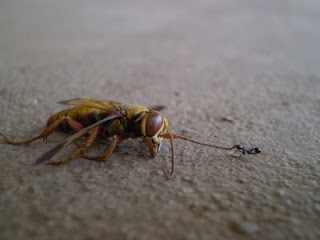I have had the privilege of spending the last couple of weeks at my mother's farm. One evening while I was there, I was down the
paddock winding down a little bonfire we'd had to clear away some old branches, when I saw what I at first thought was a
harrier hawk fly up towards me from some bushes across the road, near the river. Harrier hawks are a relatively common sight at the farm, so
I didn't think much of it, although I rarely see them that close –
often I just see them soaring in high circles above the farmland. A
split second later, I noticed it was carrying a small bird in its
talons (sparrow sized, but otherwise unidentifiable in the poor
light). It flew to the top of a nearby power pole, where over the
course of the next 40 minutes I stood in awe as it consumed its prey. It looked
stockier and smaller than a harrier should have been, standing atop
the power pole, and I began to suspect I was observing a NZ falcon
instead. A google search when I returned to the house confirmed that
it was indeed the NZ falcon, Falco novaeseelandiae.

The NZ falcon or karearea as it is also
known, is New Zealand's only extant (non-extinct) endemic bird of prey.
Our other native birds of prey such as the morepork and harrier hawk
are also found naturally in Australia and some islands of the
southwest Pacific. The NZ falcon actively hunts other birds, including those
much larger than itself, such as the native pigeon (kereru). We've
found piles of kereru feathers before, sometimes with a skeleton
nearby, and thought it was probably the work of the falcon. I've
heard stories of the falcon killing chickens and ducks too. They dive bomb
their prey at speeds of over 100km/hr, not giving their prey much
chance for escape or retaliation. They are also quite aggressive in defending
their territory, especially during the nesting season, and will
attack dogs and even people. A few years ago, when I was a volunteer
doing rat trapping at a nearby national park, when working in an area where a group of
falcon's had nests, I was advised to carry a stick of perhaps 5cm
diameter so that the top of it stuck up a little above my head. Fortunately, they never tried to attack me, but the idea was that if one
were to attack, it would swoop down and take out the stick rather
than my scalp.

I watched the falcon, on top of the power pole, as it preceded to pluck its prey, the downy black feathers floating off in the
breeze like bits of ash from the bonfire we'd had that afternoon. After a time the flow of
feathers trickled to a stop as the falcon began to eat its prey. It'd take a
bite or two, then pause, lifting its head to look around, before
returning for another mouthful. It held the carcass still with a foot, while plucking off the feathers that it discarded, and then the meat which it consumed. At one point it nearly lost the carcass as it slid off the edge of the cross bar on the power pole, but the falcon quickly grabbed it with its talons, and repositioned it back on the cross bar. It would have been interesting to have seen what would have happened had it not been able to catch the carcass before it fell to the ground. Would it have retrieved it, or abandoned it? Luckily for the falcon, it was not an issue that evening, and I will have to wait for another day to find the answer to that question. After a while, as it neared the end of its meal, I saw it regurgitate up some bits - apparently inedible bits that it had consumed. I knew the morepork does this, regurgitating up pellets of bones, fur, feathers and other inedible bits from the mice and other little creatures it hunts. I learned that the falcon commonly does this too after a meal. When it was done, it quietly flew off.

I suppose some would find it was perhaps a bit of a gruesome scene to observe, yet to me it was highly fascinating and I felt incredibly lucky that I'd had the privilege of witnessing it. Although I have seen the NZ falcon once or twice before, it was both the first time that I had seen one at the farm and the first time I'd seen one with prey. The world is full of amazing creatures, and to me this was another example of that.






















































